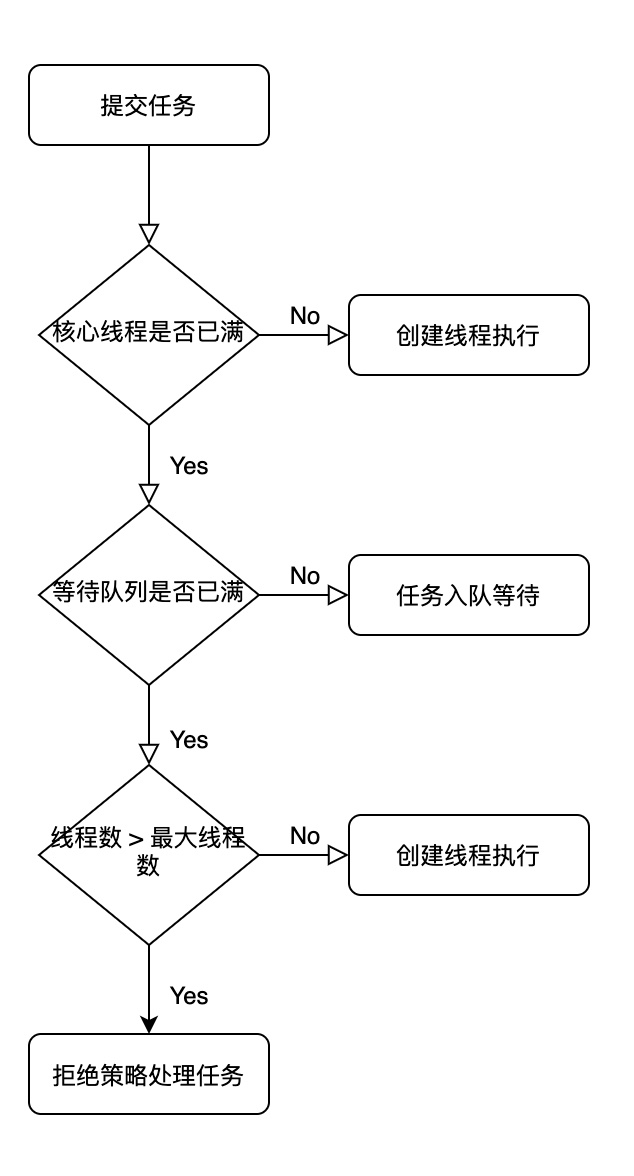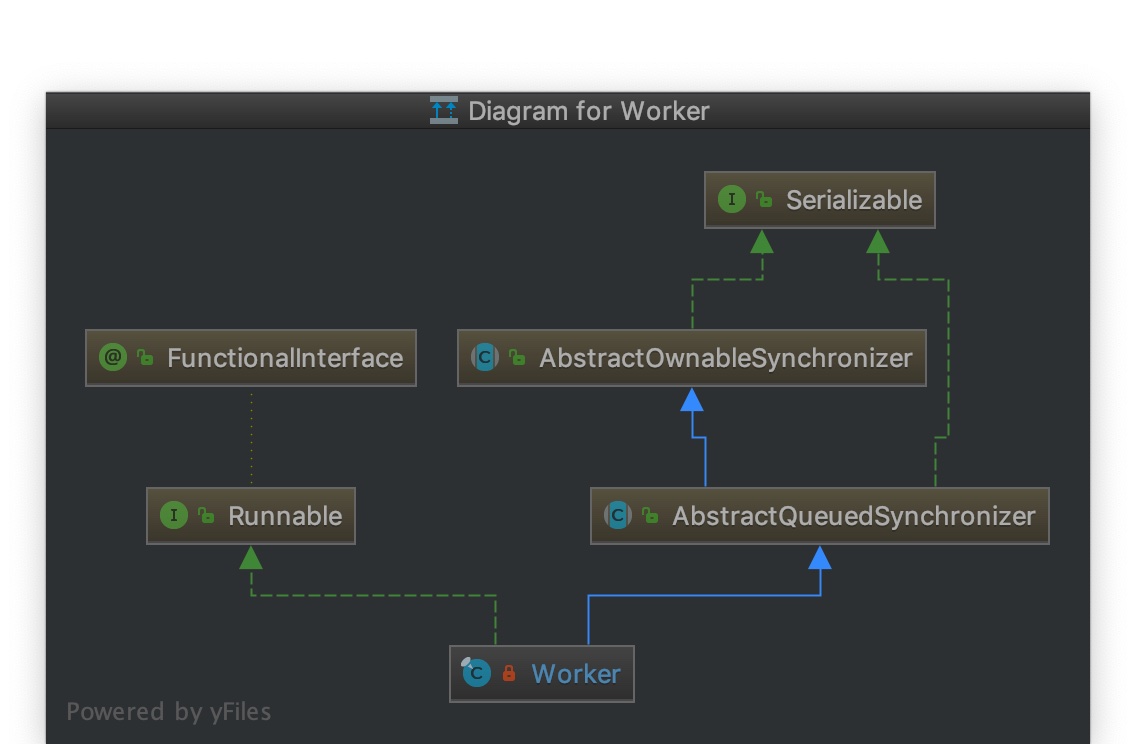1. 线程池使用
// 1. 创建核心线程数为2,最大线程数为10的线程池
ThreadPoolExecutor executor = new ThreadPoolExecutor(2, 10, 60,TimeUnit.SECONDS, new LinkedBlockingDeque<>(50), new ThreadPoolExecutor.CallerRunsPolicy());
executor.prestartAllCoreThreads();//启动所有核心线程,即创建空任务,激活线程并自旋
Runnable runnable = () -> {
//do something
System.out.println("run");
};
// 2. 提交并执行任务
IntStream.range(0, 100).forEach(e -> {
executor.execute(runnable);
});
// 3. 关闭线程池
if (!executor.isShutdown()) {
executor.shutdown();
}
2. 线程池执行流程

3. 源码分析
1. 线程池构造器参数介绍
2. 提交任务方法
public void execute(Runnable command) {
// 若任务为空直接异常
if (command == null)
throw new NullPointerException();
int c = ctl.get();
// 若当前工作线程数<核心线程数,则调用addWorker创建线程并执行任务
if (workerCountOf(c) < corePoolSize) {
if (addWorker(command, true))
return;
c = ctl.get();
}
// 若大于corePoolSize,则任务入队列中等待
if (isRunning(c) && workQueue.offer(command)) {
int recheck = ctl.get();
// 再次检测线程状态,若不是Running且成功从队列中删除,则任务由拒绝策略处理
if (! isRunning(recheck) && remove(command))
reject(command);
// 若线程数空的,则新建一个线程
else if (workerCountOf(recheck) == 0)
addWorker(null, false);
}
// 队列满了且线程数大于最大线程数,则任务由拒绝策略处理
else if (!addWorker(command, false))
reject(command);
}
3. 添加线程方法
private boolean addWorker(Runnable firstTask, boolean core) {
retry:
for (;;) {
int c = ctl.get();
int rs = runStateOf(c);
// Check if queue empty only if necessary.
// 线程是否关闭,
if (rs >= SHUTDOWN &&
! (rs == SHUTDOWN &&
firstTask == null &&
! workQueue.isEmpty()))
return false;
for (;;) {
int wc = workerCountOf(c);
// 非核心线程,若线程数大于最大线程数,则失败,返回false
if (wc >= CAPACITY ||
wc >= (core ? corePoolSize : maximumPoolSize))
return false;
// 若cas修改成功,跳出外层循环
if (compareAndIncrementWorkerCount(c))
break retry;
// 若失败,再次检测
c = ctl.get(); // Re-read ctl
if (runStateOf(c) != rs)
continue retry;
// else CAS failed due to workerCount change; retry inner loop
}
}
// 线程是否执行成功标识
boolean workerStarted = false;
// 是否添加线程成功标识
boolean workerAdded = false;
Worker w = null;
try {
// 新建线程
w = new Worker(firstTask);
final Thread t = w.thread;
if (t != null) {
final ReentrantLock mainLock = this.mainLock;
// 加锁
mainLock.lock();
try {
// Recheck while holding lock.
// Back out on ThreadFactory failure or if
// shut down before lock acquired.
int rs = runStateOf(ctl.get());
if (rs < SHUTDOWN ||
(rs == SHUTDOWN && firstTask == null)) {
if (t.isAlive()) // precheck that t is startable
throw new IllegalThreadStateException();
// 添加到set中
workers.add(w);
int s = workers.size();
// 数线程数量
if (s > largestPoolSize)
largestPoolSize = s;
// 添加线程成功
workerAdded = true;
}
} finally {
// 释放锁资源
mainLock.unlock();
}
// 若添加线程成功,则执行任务
if (workerAdded) {
// *调用 Worker.run()
t.start();
// 线程执行成功
workerStarted = true;
}
}
} finally {
// 若线程执行失败,则中set中删除线程
if (! workerStarted)
addWorkerFailed(w);
}
return workerStarted;
}
4. Worker.run()
Worker继承关系

Worker实现了Runnable,所以 addWorker()中执行线程最终调用的是Worker的run方法
runWorker()
final void runWorker(Worker w) {
Thread wt = Thread.currentThread();
Runnable task = w.firstTask;
w.firstTask = null;
w.unlock(); // allow interrupts
boolean completedAbruptly = true;
try {
// 若核心线程的任务为空,则中队列中获取,*getTask()
while (task != null || (task = getTask()) != null) {
// 加锁
w.lock();
// If pool is stopping, ensure thread is interrupted;
// if not, ensure thread is not interrupted. This
// requires a recheck in second case to deal with
// shutdownNow race while clearing interrupt
if ((runStateAtLeast(ctl.get(), STOP) ||
(Thread.interrupted() &&
runStateAtLeast(ctl.get(), STOP))) &&
!wt.isInterrupted())
wt.interrupt();
try {
beforeExecute(wt, task);
Throwable thrown = null;
try {
// 执行任务
task.run();
} catch (RuntimeException x) {
thrown = x; throw x;
} catch (Error x) {
thrown = x; throw x;
} catch (Throwable x) {
thrown = x; throw new Error(x);
} finally {
afterExecute(task, thrown);
}
} finally {
task = null;
// 完成的任务数量
w.completedTasks++;
// 释放锁
w.unlock();
}
}
completedAbruptly = false;
} finally {
processWorkerExit(w, completedAbruptly);
}
}
5. getTask()
private Runnable getTask() {
boolean timedOut = false; // Did the last poll() time out?
for (;;) {
int c = ctl.get();
int rs = runStateOf(c);
// Check if queue empty only if necessary.
if (rs >= SHUTDOWN && (rs >= STOP || workQueue.isEmpty())) {
decrementWorkerCount();
return null;
}
int wc = workerCountOf(c);
// Are workers subject to culling?
// 若大于核心线程数,则超时
boolean timed = allowCoreThreadTimeOut || wc > corePoolSize;
if ((wc > maximumPoolSize || (timed && timedOut))
&& (wc > 1 || workQueue.isEmpty())) {
if (compareAndDecrementWorkerCount(c))
return null;
continue;
}
try {
// 如果超时,且队列中没有任务,则一直堵塞,若未超时则直接获取队头任务
Runnable r = timed ?
workQueue.poll(keepAliveTime, TimeUnit.NANOSECONDS) :
workQueue.take();
if (r != null)
return r;
timedOut = true;
} catch (InterruptedException retry) {
timedOut = false;
}
}
}
4. 总结
线程池执行任务过程:ThreadPoolExecutor$execute -> ThreadPoolExecutor$addWorker -> Thead$start -> Worker$run -> Worker$runWorker -> ThreadPoolExecutor$getTask
getTask自旋尝试获取任务并返回,若队列中没有任务则堵塞当前线程;runWorker自旋执行getTask返回的任务